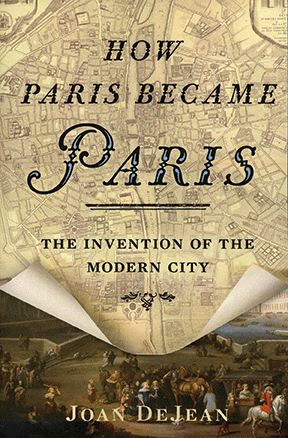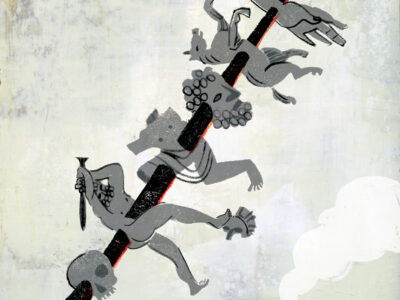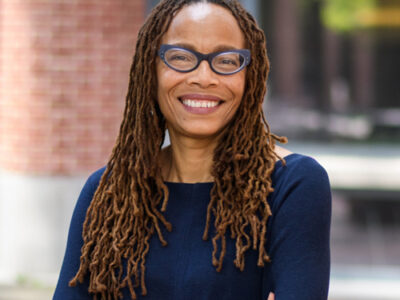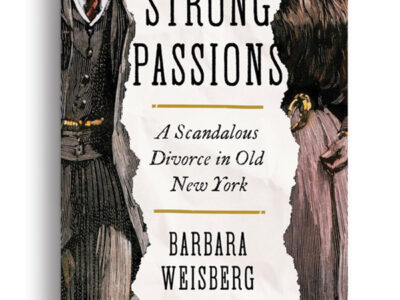A new book illuminates the urbane foundations of Paris.

HOW PARIS BECAME PARIS
The Invention of the Modern City
By Joan DeJean, faculty
Bloomsbury, 2014, $30.
By Dennis Drabelle | The last time you and I saw Paris, it was a tale of Haussmann. Baron Georges-Eugène Haussmann, that is, the 19th-century bureaucrat who, at the behest of Emperor Napoleon III, remade Paris into the city of broad, elegant streets and monumental public spaces over which the world still swoons.
But that’s giving Haussmann too much credit, argues Joan DeJean, Trustee Professor of Romance Languages at Penn, in her spirited book How Paris Became Paris.
By the time Haussmann got down to work, she notes, Paris had long since assumed its roles as bellwether for urban grandeur, center of fashion and conspicuous consumption, and setting for romance and amorous adventure. Indeed, DeJean goes so far as to say that the projects realized under Haussmann’s direction were “largely derivative of … models created in the seventeenth century.”
DeJean makes her case both verbally and pictorially, sprinkling the text with paintings, drawings, and maps that illustrate changes to Paris wrought mostly during the long reign of Louis XIV (1643-1715). She starts, however, with innovations dating back to Henri IV, who reigned from 1589 to 1610. One addition was the Pont Neuf, built across the Seine at the western tip of the Ile de la Cité. In an age when “bridges were cruelly lacking in all major cities,” she points out, the new span proved not just useful but also beautiful, so much so that it became “the first major modern tourist destination.”
Another new asset was the Place Royale, begun under Henri IV and completed under the aegis of his widow, Marie de Médicis, in 1612. Here the problem to be addressed was the dearth of opportunity for residents of a congested and rapidly growing city to gather, mingle, and have fun. “With the Place Royale,” DeJean sums up, “Paris acquired the first purpose-built public recreational space in any European capital.”
After the bridge and the place came a real novelty: the remaking of an island, the Ile Saint-Louis, on which was imposed a uniform style of domestic architecture dominated by the white-stone look that soon became the face of Paris.
“Credit for the city’s architectural distinction is always given to Baron Haussmann,” DeJean reminds us. “And yet, two hundred and fifty years before Haussmann decreed the demolition of the grandest of its mansions, an artificial island in the Seine had convinced the greatest [contemporary] architects … that it held the key to the future of Parisian architecture and of notable urban architecture in general.”
One of DeJean’s most telling visuals is a “before” map of the city, drawn in 1572. Without exactly going nowhere, the streets start, stop, dither, widen, narrow, and branch off indiscriminately—as well they might, having sprung up to serve one household after another rather than the city as a whole. A century later, this higgledy-piggledy approach had given way to rational design, which can be seen on a 1676 map drawn at the Sun King’s request by architects Pierre Bullet and François Blondel.
With planning came the avenue and boulevard. The most spectacular of these dressed-up thoroughfares was the Champs Elysées, not just a traffic artery but also a prototype of the urban park. In case that wasn’t enough, Paris soon created a full-blown urban park, the Tuileries Garden, which came to fruition at a time when the city was earning a reputation as a producer of luxury goods.
“When Parisians took to their feet in the Tuileries,” DeJean writes, “they were … able to show off typically Parisian garments and accessories just as soon as they had been invented … The entire modern spectacle of high style, every red carpet walk, has its origins in the daily parade that began in the Tuileries in the 1670s.”
DeJean’s tour goes on to encompass other Parisian gifts to urbanity, including a postal system, street lighting, and indoor shopping at fixed prices (as opposed to haggling at outdoor stalls), all of which conspired to make the city the envy of Europe. By the same token, the Parisian flair for style and luxury paved the way for a striking change in a basic human activity: for many people, shopping evolved from a chore into a pleasure. Merchants encouraged recreational shopping by providing what DeJean calls “the overstimulation and momentary loss of self-control that increase the likelihood of impulse purchases.”
Readers may wish that DeJean had paid more attention to the personages who embody or comment upon her historical forces. Take, for example, Cardinal Jules Mazarin, the Italian-born chief adviser to King Louis XIII and his successor, Louis XIV. DeJean mentions that Parisians “reviled” Mazarin for his corrupt behavior in office, but he remains a shadowy figure here. A short profile of the cardinal would have helped explain how resentment of Mazarin almost sparked a French revolution a century-and-a-half ahead of schedule. Others deserving such treatment include the great letter-writer Madame de Sévigné (often quoted by DeJean), the finance minister Jean-Baptiste Colbert, and the Sun King himself.
On the whole, though, DeJean lays out her thesis with those quintessentially French qualities, clarity and wit. Toward the end, she reminds us of the many terms for features of early modern Paris that went straight into other languages: besides avenue and boulevard, the list includes balcony, parvenu, nouveau riche, coquette, financier, and millionaire. In her telling, it makes perfect sense that ultra-urban Paris should have contributed so much to how we talk about the modern city.




